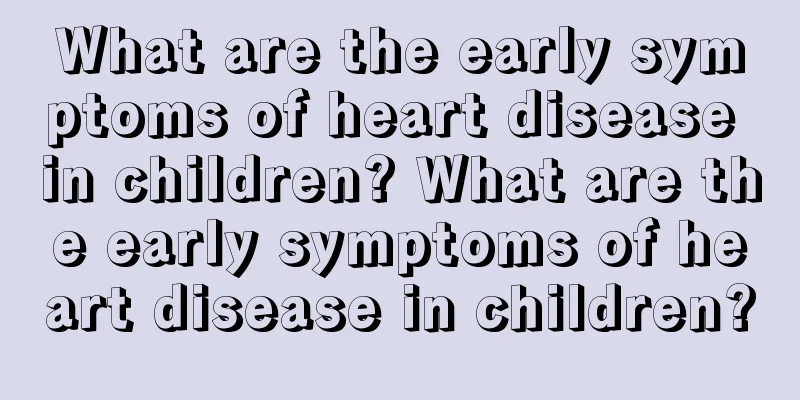What does whooping cough mean? Is whooping cough contagious?

|
The "whooping cough" in "whooping cough" does not mean coughing for 100 days, but an acute respiratory infectious disease caused by Bordetella pertussis. Many infants and young children are susceptible to this disease, and it is highly contagious, so how can we prevent it in our daily lives? What does the "pertussis" in whooping cough mean?Whooping cough is an acute respiratory infectious disease caused by Bordetella pertussis, which is more common in children under 5 years old. It is characterized by paroxysmal spasmodic coughs accompanied by deep cock-like inspiratory roars. The incubation period of this disease is generally 7 to 14 days, and the longest is 21 days. At the onset, cold symptoms appear, including cough, runny nose, and low fever. After about a week, the cough worsens, often with mild symptoms during the day and severe symptoms at night, and there will be obvious paroxysmal spasmodic coughs, with continuous coughs for more than a dozen or even dozens of times, until sputum is coughed up or the contents of the stomach are vomited out, followed by a deep and long inhalation with a high-pitched cock-like inspiratory roar, commonly known as the "hook-back sound". Repeated attacks of clonic coughs often make children's faces flushed and breathless. Severe coughs can cause cyanosis of the corners of the eyes and subconjunctival hemorrhage of the eyeball. After about 2 to 6 weeks, and for severe cases for more than 2 months, the spasmodic cough begins to ease, and the cough gradually eases. It lasts for another 2 to 3 weeks before the cough stops. Due to long-term coughing, vomiting and poor rest, the physical condition of the children declines, and they are prone to complications such as pneumonia, otitis media, and toxic encephalopathy, which seriously affect the health of children. Therefore, active prevention and treatment must be carried out. Is whooping cough contagious?The disease is highly contagious and often causes epidemics. The younger the child, the more severe the condition, and the child may die from complications of pneumonia and encephalopathy. 40% of the deaths are infants under 5 months old. In the past 30 years, due to the widespread vaccination of vaccines, the prevalence of pertussis in my country has been greatly reduced, and the morbidity and mortality rates have also been significantly reduced. Whooping cough is common all over the world, usually in a sporadic manner, and can occur in collective children's institutions. It can occur throughout the year, but is more common in winter and spring, and can extend to late spring and early summer, and even peak in June, July, and August. Whooping cough patients are the only source of infection, including typical patients and mild patients. Bordetella pertussis is not easy to survive in the external environment, and can only grow and reproduce in the mucous membrane of the upper respiratory tract, and spread with droplets. Therefore, the main route of transmission of whooping cough is through droplets during coughing, and the bacteria may be inhaled within about 2 meters around the patient. Bordetella pertussis dies quickly outside the body. Therefore, it is rarely transmitted indirectly through clothing, utensils, etc. In addition, the general population is susceptible to pertussis, and the strongest susceptibility is in children, especially infants. About 2/3 of the cases are children under 7 years old. This is because the mother does not have Bordetella pertussis antibodies that are passed to the fetus through the placenta during pregnancy. Therefore, newborns can be infected with the disease after birth. The younger the age, the higher the mortality rate. After suffering from pertussis, you can obtain lasting immunity. It is rare to have pertussis twice in a lifetime. Pertussis is a common acute respiratory infectious disease in children, an acute respiratory infectious disease caused by Bordetella pertussis. The clinical characteristics are paroxysmal spasmodic cough, cock-like inhalation sound, and increased lymphocytes in peripheral blood. The course of the disease is long and can last for 2 to 3 months without treatment. Therefore, it is called "whooping cough". Young infants are prone to complications such as suffocation, pneumonia, and encephalopathy when they are infected with this disease, and the mortality rate is high. In recent years, the incidence of whooping cough in young infants has been increasing. In recent years, there have been many reports of adults suffering from whooping cough, mainly manifested as dry cough, lack of paroxysmal spasmodic cough. The younger the age, the worse the prognosis. Infants and young children have a poor prognosis for whooping cough encephalopathy and bronchopneumonia. In recent years, due to early treatment of multiple functions, the mortality rate has been significantly reduced; however, newborns and infants are prone to complications of pneumonia and encephalopathy, and the prognosis is still critical. Children with rickets who are infected with whooping cough usually have a more severe illness. Whooping cough is contagious to adults, and there have been many adult patients. Adult patients have typical symptoms and vomiting after coughing, but they may only have a dry cough for several weeks, and complications are rare. People who have had this disease usually have good immunity, but because other bacteria can cause symptoms similar to whooping cough, it is possible that it looks like a recurrence on the surface. And many people are infected for the second time. Therefore, it is currently believed that natural infection cannot provide lifelong immunity. How to prevent whooping cough infection1. Control the source of infection: During the epidemic season, all confirmed patients should be isolated immediately until 40 days after the onset of illness, or 30 days after the onset of spasmodic cough. Contacts should be closely observed for at least 3 weeks, and antibiotic treatment should be given as soon as possible if there are prodromal symptoms. 2. Cut off the transmission route: Since Bordetella pertussis has weak resistance to the outside world, no disinfection is required, but the room should be ventilated, clothes should be exposed to the sun, and sputum and oral and nasal secretions should be disinfected. 3. Improve the immunity of the population: The pertussis vaccines currently used for vaccination include whole-cell vaccines and acellular vaccines. Whole-cell vaccines are conventional vaccines. Sometimes pertussis will cause intensive infection. Why is this? How to prevent it? Take a look at the following suggestions. 4. Drug prevention: For infants and weak children who have not been vaccinated but have close contact with pertussis patients, 2.5 ml of pertussis immunoglobulin or 10-20 ml of convalescent serum can be injected intramuscularly, and the injection should be repeated once every 5-7 days for 3 times in a row, which can temporarily prevent the disease. Recently, it has been confirmed that erythromycin can reduce the infection rate of pertussis contacts. The dose is 30-50 mg/kg body weight, taken orally in 4 times for 5-7 days, which helps to control the spread of pertussis. Some people also choose compound sulfamethoxazole. Infants under six months old can use 5 ml of the drug emulsion (containing TMP40 mg and SMZ200 mg), twice a day, for 7-10 days. |
<<: Can a retroverted uterus cause infertility? What should I do if I have a retroverted uterus?
>>: A complete guide to how to eat shrimps for babies. How to eat shrimps for babies?
Recommend
Teaching by example is the best educational concept
Children need their parents' care from a youn...
Is Xie Na pregnant with twins? Is Xie Na pregnant with twins?
Xie Na just announced her pregnancy on Weibo. So ...
Can I eat yam after I get pregnant? Yam can promote fetal development
A few days ago, a pregnant mother asked me if I c...
Why does the baby sleep with his mouth open? How to correct the baby sleeping with his mouth open?
It's cute for babies to sleep with their mout...
What should I eat to increase my milk supply after childbirth? What should I eat to increase my milk supply after childbirth?
If a pregnant woman has insufficient milk after c...
The harm of air fresheners to people How long does it take for air fresheners to evaporate?
Air freshener is a product that we are all famili...
Why does the baby have a fever? Why does the baby have a fever?
The immune system of young children is not fully ...
What should I do if my baby's stool is green? How should I deal with my baby's accidental burns?
The baby's physical condition often requires ...
Why do children like to watch cartoons? What are the benefits?
Whenever the TV is turned on, especially when the...
How are Shishuang diapers? Real evaluation of Shishuang diapers
Diapers are an indispensable item for every baby....
Are noise-isolating earplugs useful? Which is better, noise-isolating earplugs or noise-isolating earmuffs?
I always feel a little noisy when sleeping recent...
What should I do if my child is not tall enough? What should I eat if my child is not tall enough?
Growing taller is a question that everyone is con...
Can pregnant women eat Baxian fruit? Who are not suitable for eating Baxian fruit?
Baxian fruit is not a fruit, but a processed deli...
Can babies drink green tea? What are the side effects?
Green tea is very helpful for our health. It can ...
What should I do if I bleed during the third trimester of pregnancy? ...
Many mothers will experience bleeding during preg...









